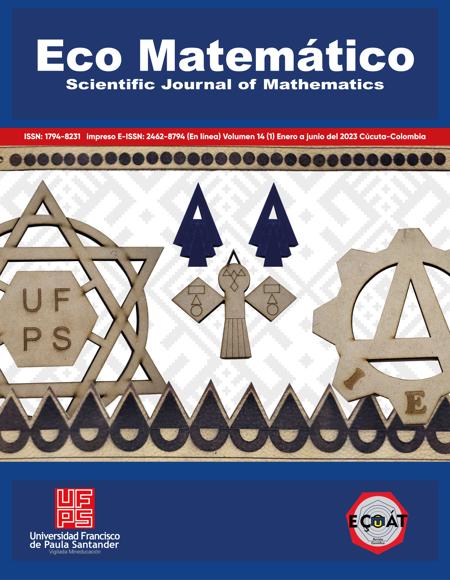Statistical literacy in graduate students of the National Experimental University of Táchira
Alfabetización estadística en estudiantes de postgrado de la Universidad Nacional Experimental del Táchira
Main Article Content
The objective of this research was to determine statistical literacy in postgraduate students of the National Experimental University of Táchira (UNET). Methodologically, it relied on the positivist paradigm, descriptive level, field design, transectional, non-experimental. The population consisted of 70 students from the academic periods 2019-B and 2019-D, all of which were selected as a study sample. For data collection, the survey was considered based on two types of instruments: an objective test of 28 questions with four answer options to evaluate knowledge, notions and skills in topics related to statistics and a scale of Attitudes towards Statistics of 25 Likert-type items introduced by Estrada (2002) with five response options. Both instruments were validated using the expert judgment technique and their reliability was determined through the internal consistency coefficients Kuder-Richardson and Cronbach's Alpha, obtaining the following values: 0.81 and 0.82, respectively. Among the most outstanding results, it stands out that 63% of the students studied statistics in undergraduate studies, but only 42.9% during postgraduate studies; likewise, 51.4% are unaware of the term statistical literacy. Regarding statistical knowledge, it can be said that in general terms they present some weaknesses that could be overcome through statistical literacy strategies. However, students show an accepting attitude towards statistics, but have the belief that it is difficult because it prevents them from solving statistical problems.
Downloads
Publication Facts
Reviewer profiles N/A
Author statements
Indexed in
- Academic society
- Universidad Francisco de Paula Santander
- Publisher
- Universidad Francisco de Paula Santander
Article Details
Andonegui, J. (2000). Valores y evaluación. Un apoyo para el docente. Caracas: Tondona.
Arias, F. (2012). El proyecto de investigación. Introducción a la metodología científica. (6ª. Ed.) Caracas: Espíteme.
Batanero, C. (2000). Significado y comprensión de las medidas de posición central. Uno - Revista de Didáctica de las Matemáticas, 25, 41-58.
Batanero, C. (2001). Didáctica de la estadística. Grupo de Investigación en Educación Estadística. Departamento de Didáctica de la Matemática. Universidad de Granada.
Batanero, C. (2002). Los retos de la cultura estadística. Conferencia inaugural de las Jornadas Interamericanas de la Enseñanza de la Estadística. Recuperado de: http://www.ugr.es/~batanero/pages/ARTICULOS/CULTURA.pdf
Ben-Zvi, D., & Garfield, J. (2004). Statistical literacy, reasoning, and thinking: Goals, definitions, and challenges. En D. Ben-Zvi, & J. Garfield, The challenge of developing statistical literacy, reasoning and thinking (págs. 3 - 15). Dordrecht, The Netherlands: Kluwer. https://doi.org/10.1007/1-4020-2278-6_1 DOI: https://doi.org/10.1007/1-4020-2278-6
Briñol, P., Falces, C. y Becerra, A. (2007). Actitudes. En F. Morales, M. Moya, I. Cuadrado, & E. Gaviria, Psicología Social (pp. 457- 490). Madrid: Mc Graw Hill.
Carmona, J. (2004). Una revisión de las evidencias de fiabilidad y validez de los cuestionarios de actitudes y ansiedad hacia la estadística.
Díaz, E. (2004). El factor actitudinal en la atención a la diversidad. Profesorado, revista de currículum y formación del profesorado, 6(1-2), 151- 165. Recuperado de: https://www.ugr.es/~recfpro/rev61COL3.pdf
Escalante, E. (2009). Actitudes de alumnos de posgrado hacia la estadística aplicada a la investigación. Encuentro 2010/ Año XLII, N° 85, 27-38. Recuperado de: https://doi.org/10.5377/encuentro.v42i85.57
Estrada, M. (2002). Análisis de las actitudes y conocimientos estadísticos elementales en la formación del profesorado. [Tesis doctoral en línea]. Universidad Autónoma de Barcelona.
Eudave, D. (2007). El aprendizaje de la estadística en estudiantes universitarios de profesiones no matemáticas. Educación Matemática, 19(2), agosto, 2007, 41-66.
Gal, I. (2002). Adults' Statitistical Literacy: Meanings, Components, Responsabili-dades. International Statistical Review, 70(1) 1-51. https://doi.org/10.2307/1403713 DOI: https://doi.org/10.2307/1403713
Gal, I. (2004). Statistical Literacy Meanings, Components, Responsibilities. In: Ben-Zvi, Dani; Garfield, Joan (Ed.). The Challenge of Developing Statistical Literacy, Reasoning and Thinking. Netherlands: Springer. 47-78. https://doi.org/10.1007/1-4020-2278-6_3 DOI: https://doi.org/10.1007/1-4020-2278-6_3
Garfield, J., Delmas, R. & Chance, B. (2003). The Web-Based ARTIST: assessment resource tools for improving statistical thinking. In: Assessment of statistical reasoning to enhance educational quality, at the annual meeting of the american educational research association (AERA), 2003, Chicago. Anais... Chicago: 2003. P. 1-22. Recuperado de: https://apps3.cehd.umn.edu/artist /articles/AERA_2003.pdf.
Gómez, E. (2010). Actitudes de alumnos de posgrado hacia la estadística aplicada a la investigación. Encuentro 2010/ Año XLII, N° 85, 27-38. Recuperado de: https://doi.org/10.5377/encuentro.v42i85.57 DOI: https://doi.org/10.5377/encuentro.v42i85.57
Mato, D. (2006). Diseño y validación de dos cuestionarios para evaluar las actitudes y la ansiedad hacia las matemáticas en alumnos de educación secundaria obligatoria [Tesis doctoral en línea]. Universidad de la Coruña, Coruña. Recuperado de: https://ruc.udc.es/dspace/handle/2183/12688
Moreno, E. (2013). Importancia de hipótesis en una investigación. Recuperado de: http://tesis-investigacion-cientifica.blogspot.com/2013/08/importancia-de-hipotesis-en-una.html
Sanoja, J. (2015). Alfabetización estadística del futuro profesor de matemática. Recuperado de: http://funes.uniandes.edu.co/8364/1/Cap%C3%ADtulo_13_Alfabetizaci%C3%B3n_Estad%C3%ADstica_JES.pdf
Sanoja, J. y Ortiz, J. (2013). Conocimiento de contenido estadístico de los maestros. En J. M. Contreras, G. R. Cañadas, M. M. Gea y P. Arteaga (Eds.) Actas de las Jornadas Virtuales en Didáctica de la Estadística, Probabilidad y Combinatoria (pp. 157-164). Granada, Departamento de Didáctica de la Matemática de la Universidad de Granada, 2013. Recuperado de: http://www.jvdiesproyco.es/documentos/ACTAS/2%20 Comunicacion% 2012.pdf.
Schield, M. (2010). Assessing Statistical Literacy: Take CARE. En P. Bidgood, N. Hunt, & F. Jolliffe (eds.) Assessment Methods in Statistical Education: An International Perspective, 133-152. John Wiley & Sons Inc: Chischester, Great Britain. Recuperado de: https://doi.org/10.1002/9780470710470.ch11 DOI: https://doi.org/10.1002/9780470710470.ch11
Rodríguez, F. (2017). Alfabetización Estadística en Profesores de Distintos Niveles Formativos. Educação & Realidade, 42(4), 1459-1477. http://dx.doi.org/10.1590/2175-623662610. DOI: https://doi.org/10.1590/2175-623662610
Rodríguez, F., Pierdant, A. y Rodríguez, E. (2016). Estadística para Administración. México: Grupo Editorial Patria, S.A. de C.V.
Ruiz, C. (2002). Instrumentos de Investigación Educativa, Procedimientos para su Diseño y Validación. Barquisimeto: CIDEG.
Wallman, K. (1993). Enhancing statistical literacy: Enriching our society. Journal of the American Statistical Association, 88, 1-8. https://doi.org/10.1080/01621459.1993.10594283 DOI: https://doi.org/10.1080/01621459.1993.10594283
Zabala, J. (2014). Actitud hacia la estadística: un estudio con estudiantes de los programas de la facultad de ciencias humanas y artes de la Universidad del Tolima. [Trabajo de grado en línea]. Universidad de Tolima, Colombia. Recuperado de: http://45.71.7.21/bitstream/001/1998/1/JOHN%20JAIRO%20ZABALA%20CORRALES_versio%CC%81n%20aprobada%20%281%29.pdf








